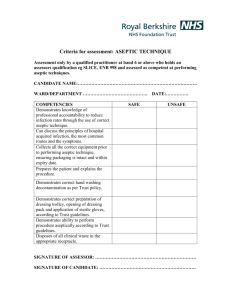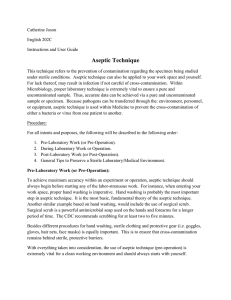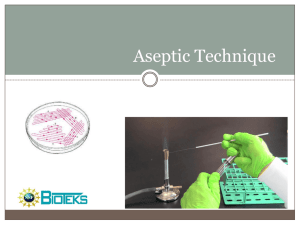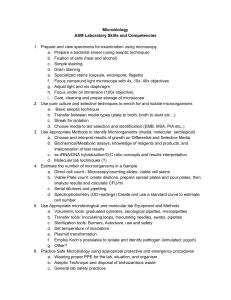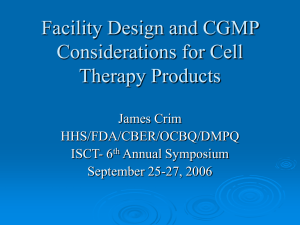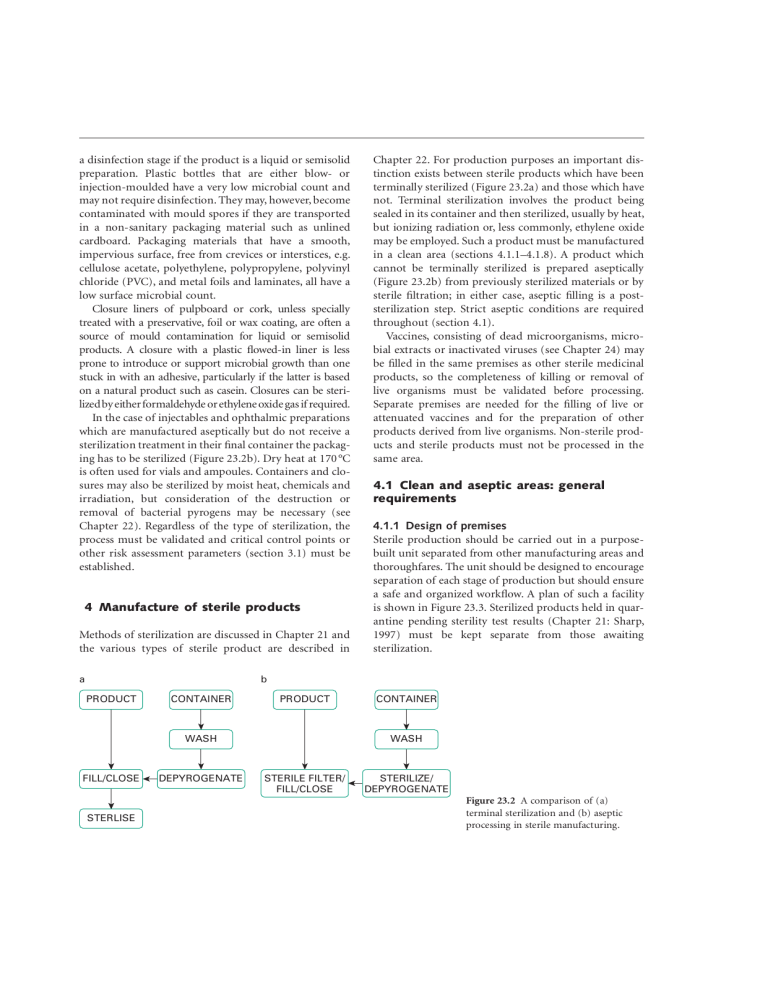
a disinfection stage if the product is a liquid or semisolid preparation. Plastic bottles that are either blow- or injection-moulded have a very low microbial count and may not require disinfection. They may, however, become contaminated with mould spores if they are transported in a non-sanitary packaging material such as unlined cardboard. Packaging materials that have a smooth, impervious surface, free from crevices or interstices, e.g. cellulose acetate, polyethylene, polypropylene, polyvinyl chloride (PVC), and metal foils and laminates, all have a low surface microbial count. Closure liners of pulpboard or cork, unless specially treated with a preservative, foil or wax coating, are often a source of mould contamination for liquid or semisolid products. A closure with a plastic flowed-in liner is less prone to introduce or support microbial growth than one stuck in with an adhesive, particularly if the latter is based on a natural product such as casein. Closures can be sterilized by either formaldehyde or ethylene oxide gas if required. In the case of injectables and ophthalmic preparations which are manufactured aseptically but do not receive a sterilization treatment in their final container the packaging has to be sterilized (Figure 23.2b). Dry heat at 170 °C is often used for vials and ampoules. Containers and closures may also be sterilized by moist heat, chemicals and irradiation, but consideration of the destruction or removal of bacterial pyrogens may be necessary (see Chapter 22). Regardless of the type of sterilization, the process must be validated and critical control points or other risk assessment parameters (section 3.1) must be established. 4 Manufacture of sterile products Methods of sterilization are discussed in Chapter 21 and the various types of sterile product are described in a Chapter 22. For production purposes an important distinction exists between sterile products which have been terminally sterilized (Figure 23.2a) and those which have not. Terminal sterilization involves the product being sealed in its container and then sterilized, usually by heat, but ionizing radiation or, less commonly, ethylene oxide may be employed. Such a product must be manufactured in a clean area (sections 4.1.1–4.1.8). A product which cannot be terminally sterilized is prepared aseptically (Figure 23.2b) from previously sterilized materials or by sterile filtration; in either case, aseptic filling is a poststerilization step. Strict aseptic conditions are required throughout (section 4.1). Vaccines, consisting of dead microorganisms, microbial extracts or inactivated viruses (see Chapter 24) may be filled in the same premises as other sterile medicinal products, so the completeness of killing or removal of live organisms must be validated before processing. Separate premises are needed for the filling of live or attenuated vaccines and for the preparation of other products derived from live organisms. Non-sterile products and sterile products must not be processed in the same area. 4.1 Clean and aseptic areas: general requirements 4.1.1 Design of premises Sterile production should be carried out in a purpose built unit separated from other manufacturing areas and thoroughfares. The unit should be designed to encourage separation of each stage of production but should ensure a safe and organized workflow. A plan of such a facility is shown in Figure 23.3. Sterilized products held in quarantine pending sterility test results (Chapter 21: Sharp, 1997) must be kept separate from those awaiting sterilization. b PRODUCT CONTAINER PRODUCT WASH FILL/CLOSE STERLISE DEPYROGENATE CONTAINER WASH STERILE FILTER/ FILL/CLOSE STERILIZE/ DEPYROGENATE Figure 23.2 A comparison of (a) terminal sterilization and (b) aseptic processing in sterile manufacturing. 3 Aseptic area Changing area 1 A B B C 6 Sterilization Figure 23.3 Example of a diagrammatic representation of the layout and workflow of a sterile products manufacturing unit. 1, the changing area in this example is built on the black (A)–grey (B)–white (C) principle; passage into the clean area is through A and B (see section 3.1.6) whereas entry to the aseptic area is first through A and B followed by C (see section 3.2.2). 2, Dividing step-over sill. 3, For details of aseptic area requirements, see text; a laminar airflow work station would be included in this area. 4i–4iv, These areas are clean areas. In filling rooms for terminally sterilized products, care should be exercised to protect containers from airborne contamination. The final rinse point (i.e. where the containers are finally washed) should be sited as near as possible to the filling point. 5, Articles which are to be transferred directly to the aseptic area from elsewhere must be sterilized by passage through a double-ended sterilizer. Solutions manufactured in the clean area may be brought into the aseptic area through a sterilizing-grade membrane filter. 6, Double-doored hatchway through which presterilized articles may be passed into the aseptic area (see section 3.2.3). Note: inspection, holding and final packaging areas have been omitted. Direction of workflow: ––––– –––––– , for ⋅⋅ terminally sterilized products; ⋅ ⋅ ⋅ ⋅ , for aseptically prepared products; - -, shared stages of preparation. -- Staff 2 Weighing 2 5 Mixing and preparation Ingredients 4(i) 4(ii) 4(iii) 4(iv) Filling Wash Sterilization 4.1.2 Internal surfaces, fittings and floors Particulate, as well as microbial, contamination must be prevented. To this end all surfaces must be smooth and impervious in order to: (1) prevent accumulation of dust or other particulate matter; and (2) permit easily repeated cleaning and disinfection. Smooth rounded coving should be used where the wall meets the floor and the ceiling. Suitable flooring may be provided by welded sheets of PVC; cracks and open joints which might harbour dirt and microorganisms must be avoided. The preferred surfaces for walls are plastic, epoxy-coated plaster, plastic fibreglass or glass-reinforced polyester. Often the final Containers finish for the floor, wall and ceiling is achieved using continuous welded PVC sheeting. False ceilings should be adequately sealed to prevent contamination from the space above. Use should be made of well-sealed glass panels, especially in dividing walls, to ensure good visibility and allow satisfactory supervision. Doors and windows should be flush with the walls. Windows should not be openable. Internal fittings such as cupboards, drawers and shelves should be kept to a minimum. They must be sited where they do not interfere with the laminar flow of the filtered air supply. Stainless steel or laminated plastic are the preferred materials for such fittings. Stainless steel trolleys may be used to transport equipment and materials within the clean and aseptic areas but must remain confined to their respective units. Equipment must be designed so that it may be easily cleaned and sterilized or disinfected. Table 23.3 Operations carried out in the various grades of air Grade Examples of operations For terminally sterilized products 4.1.3 Services Clean and aseptic areas must be adequately illuminated; lights are best housed in translucent panels set in a false ceiling. Electrical switches and sockets must be flush with the wall or fitted outside. When required, gases should be pumped in from outside the unit. Pipes and ducts, if they must be brought into the clean area, must be sealed through the walls. Additionally, in order to prevent dust accumulation, pipes and ducts must be boxed in or readily cleanable. Alternatively, they may be sited above false ceilings. Sinks should be of stainless steel with no overfl ow, and water must be of at least potable quality. Wherever possible, drains should be avoided. If installed they must be fitted with effective, readily cleanable traps and with air breaks to prevent backflow. Any floor channels should be open, shallow and cleanable and connected to drains outside the area; they should be monitored microbiologically. Sinks and drains should be excluded from aseptic areas except where radiopharmaceuticals are being processed when sinks are a requirement. 4.1.4 Air supply Areas for sterile manufacture are classified according to the required characteristics of the environment. Each operation requires an appropriate level of microbial and particulate cleanliness; four grades (Table 23.2) are specified in The Rules and Guidance for Pharmaceutical Manufacturers and Distributors (2007). Environmental quality is substantially influenced by the air supplied to the manufacturing environment. The grades of air required for specific manufacturing activities are listed in Table 23.3. Filtered air (Chapter 22) is used to achieve the necessary standards; this should be maintained at positive pressure throughout a clean or aseptic area, with the highest pressure in the most critical rooms (aseptic or clean filling rooms) and a progressive reduction through the preparation and changing rooms (Figure 23.4); a minimum pressure differential of 10 kPa is normally required between each class of room. A minimum of 20 changes of air per hour is usual in clean and aseptic rooms. The air inlet points should be situated in or near the ceiling, with the final filters placed as close as A Filling of products, when unusually at risk B Background environment to grade A preparation areas C Preparation of solutions, when unusually at risk Filling of products D Preparation of solutions and components for subsequent filling For aseptic processes A Aseptic preparation and filling B Background environment to grade A preparation areas C Preparation of solutions to be filtered D Handling of components after washing Background for an isolator Entry to aseptic areas Black Remove outer shoes, clothing, swing legs over sill, don slippers Grey Wash and dry hands and forearms. Put on sterile hood and mask. Rewash and dry hands, forearms White Put on suit, overboots, gloves. Rinse gloved hands in antiseptic Aseptic Commence work Figure 23.4 Entry into aseptic area. possible to the point of input to the room. Equipment or furnishings must be sited so as not to interfere with laminar flow. The greatest risk of contamination of a product comes from its immediate environment. Additional protection is needed both in the filling area of the cleanroom and in the aseptic suite. This can be provided by a workstation supplied with a unidirectional flow of filtered sterile air. This is known as a laminar flow cabinet. Displacement of air may be vertical or horizontal with a typical homogeneous air flow of 0.45 m/s at the working position. Consequently airborne contamination is not added to the work space, and any generated by manipulation is swept away by the laminar air currents. A fuller description of high efficiency particulate air (HEPA) filters in laminar flow cabinets is given by Gardner and Peel (1998). The efficacy of the filters through which the air is passed should be monitored at predetermined intervals. Air quality may be monitored for bacteria and fungi by slit sampler or settle plate. Particles are measured using a discrete airborne particle counter. The latest edition of The Rules and Guidance for Pharmaceutical Manufacturers and Distributors (2007) states that particles must be monitored continuously in a grade A area and recommends it for grade B areas. It should be noted that grade A air is not the purest that can be obtained; four even cleaner grades are used in the electronics industry (ISO14644-1). 4.1.5 Clothing Clothing worn in a clean area must be of non-shedding fibres; polyester is a suitable fabric. Airborne contamination, both microbial and particulate, is reduced when trouser suits, close-fitting at the neck, wrists and ankles, are worn. Clean suits should be provided once a day, but fresh headwear, overshoes and powder-free gloves are necessary for each working session. Special laundering facilities are desirable. Additional requirements for aseptic rooms are discussed in section 5.1. 4.1.6 Changing facilities Entry to a clean or aseptic area should be through a changing room fitted with interlocking doors; this design acts as an airlock to prevent influx of air from the outside. This route is for personnel only, not for the transfer of materials and equipment. Staff entering the changing room should already be clad in the standard factory or hospital protective clothing. For entry into a clean area, passage through the changing room should be from a ‘black’ to a ‘grey’ area, via a dividing step-over sill (Figure 23.4). Movement through these areas and finally into the cleanroom is permitted only when observing a strict protocol, whereby outer garments are removed in the ‘black’ area and cleanroom trouser suits donned in the ‘grey’ area. Only after hand-washing in a sink fitted with elbow- or foot-operated taps may the operator enter the cleanroom. The changing procedure for entry to an aseptic area is described in section 5.1.2. 4.1.7 Cleaning and disinfection A strict, validated disinfection policy is necessary if microbial contamination is to be kept to a minimum. Cleaning agents used include alkaline detergents and ionic and non-ionic surfactants. A wide range of chemical disinfectants is available (Chapter 19). Clear, soluble phenolics are commonly used for interior services and fittings. Disinfectants for working surfaces are alcohols (70% ethanol or isopropanol) or, less commonly, chlorine-based agents such as hypochlorites. Skin may be disinfected with cationic detergents such as cetrimide or chlorhexidine, usually formulated with 70% alcohol to avoid the need for rinsing. Gloved hands may be disinfected with these detergents or 70% alcohol. The former have the advantage of offering residual activity. Rotation of different disinfectants reduces the risk of the emergence of resistant strains, but such rotation should be validated. In-use dilutions must not be used unless sterilized. Disinfectants and detergents for use in grade A/B areas must be sterile prior to use and formulated with water for injections. Modern sprays are fitted with devices to prevent air being sucked back, extending the life of the disinfectant. As mentioned in section 4.1.2, smooth polished surfaces are more readily cleaned. Floors and horizontal surfaces should be cleaned and disinfected daily, walls and ceilings as often as required, but the interval should not exceed 1 month. Regular microbiological monitoring should be carried out to determine the efficacy of disinfection procedures. Records must be kept and immediate remedial action taken should normal levels for that area be exceeded. 4.1.8 Operation The number of persons involved in sterile manufacture should be kept to a minimum to avoid the inevitable turbulence and shedding of particles and organisms associated with the operatives. All operations should be undertaken in a controlled and methodical manner as excessive activity may increase turbulence and particle shedding. Containers made from fibrous materials such as paper, cardboard and sacking are generally heavily contaminated (especially with moulds and bacterial spores) and should not be taken into clean areas. Ingredients which must be brought into clean areas must first be transferred to suitable metal or plastic containers. Containers and closures for terminally sterilized products must be thoroughly cleaned before use and should undergo a final washing and rinsing process in apyrogenic distilled water (which has been passed through a bacteria-proof membrane filter) immediately prior to filling. Containers and closures for use in aseptic manufacture must, in addition, be sterilized after washing and rinsing in preparation for aseptic filling (Figure 23.2). 5 Aseptic areas 5.1 Additional requirements Additional requirements for aseptic areas, over and above those discussed in sections 4.1.1–4.1.8, are discussed below. 5.1.1 Clothing Requirements in addition to those in section 4.1.5 are needed for aseptic areas. The operative is a potential source of microorganisms and it is imperative that steps are taken to prevent this contamination. The operative must wear sterile protective headwear totally enclosing hair and beard, spectacles, powder-free rubber or plastic gloves (often two pairs are worn), a non-fibre-shedding facemask (to prevent the release of droplets) and footwear. A suitable garment is a one- or two-piece trouser suit. Fresh sterile clothing should be provided each time a person enters an aseptic area. 5.1.2 Entry to aseptic areas Entry to an aseptic suite is usually through a ‘black–grey– white’ changing procedure (Figure 23.4), where white represents the highest level of cleanliness. Movement from ‘black’ to ‘white’ is via two changing rooms, the ‘grey’ area also serving as an entry to the cleanroom (Figure 23.4 and section 4.1.6). There are several types of entry system in use. More details may be found in Whyte (2010). 5.1.3 Equipment and operation Any articles entering the aseptic area should ideally be sterilized, but may be disinfected. In order to achieve this, articles should be transferred via a double-ended sterilizer or hatch (i.e. with a door at each end). If they are not to be discharged directly to the aseptic area, they should be (1) double-wrapped before sterilization; (2) transferred immediately after sterilizing into a clean environment until required; (3) transferred from this clean environment via a double-doored hatch (where the outer wrapping is removed) to the aseptic area (where the inner wrapper is removed at the workbench). Hatches and sterilizers must be designed so that only one door may be opened at any one time. Solutions manufactured in the cleanroom may be brought into the aseptic area through a sterile 0.22 μm membrane filter. Workbenches, including laminar flow units, and equipment, should be disinfected immediately before and after each work session. Equipment must be of the simplest design possible for the operation being performed. Aseptic manipulations must be carried out in the grade A air of a laminar flow cabinet or isolator. Speed, accuracy and economy of movement are essential features of good aseptic technique. It is therefore essential that workers are well trained and motivated and familiar with the task in hand. Observation and microbiological monitoring of the operator and of the environment are very important. Under no circumstances must living microorganisms, including those used for vaccine preparation (Chapter 24) and for biological monitoring be introduced into the aseptic area. 5.2 Environmental monitoring Monitoring of the environment is essential during manufacturing. It ensures that environmental requirements are being met and also helps spot trends. Air is monitored for particles (section 4.1.4) and microorganisms. Microorganisms are usually sought using settle plates or active samplers, such as the slit-toagar sampler. Settle plates rely on organisms falling from the atmosphere and settling onto an exposed agar plate. After a specified time (usually 4 hours) the plate will be covered and incubated. A slit-to-agar sampler draws in a specified volume of air, forcing organisms onto the surface of an agar plate. This latter method is able to give a viable count per volume, but organisms may be damaged and hence rendered non-viable by the capture process. Limits of viable counts for different grades of air are shown in Table 23.4. One of the limitations of traditional microbial detection is the time taken to culture bacteria and fungi. There is a great deal of interest in developing rapid (Denyer, 2007) or instantaneous (Jiang, 2009) methods of microbial detection. The nature of contamination can be informative. For example, the presence of Staphylococcus spp. suggests human-borne contamination. The adequacy of changing facilities and gowning would then be checked. In contrast, Bacillus spores would suggest environmental contamination and the entry of equipment into the cleanroom would be scrutinized.
